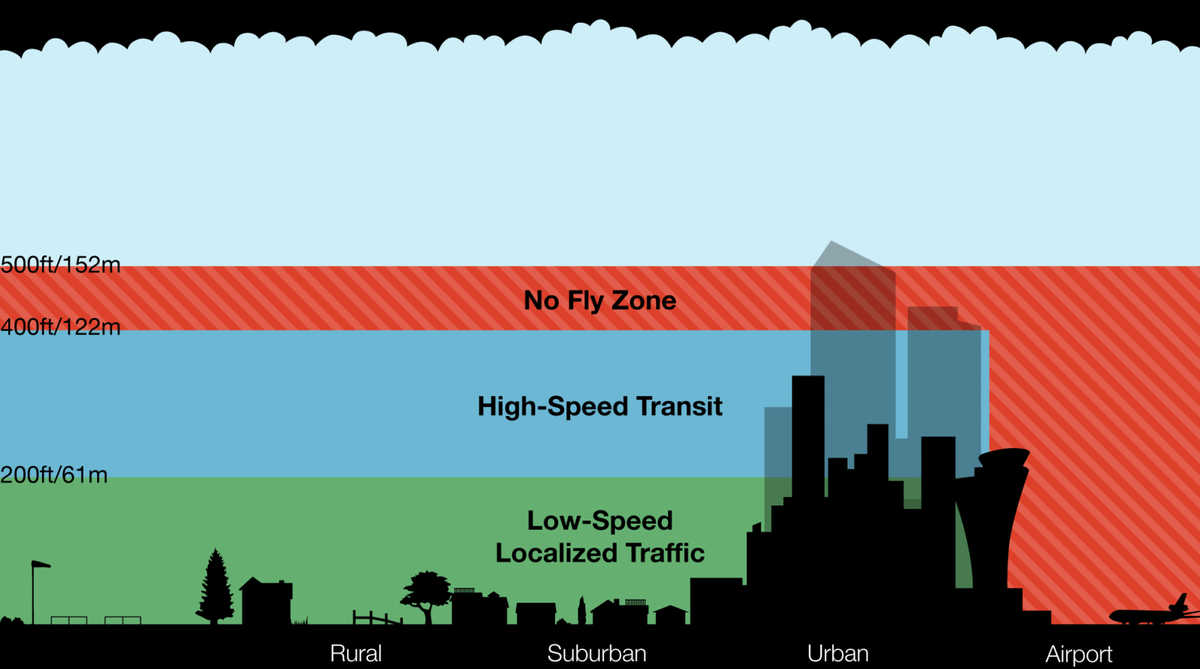[Avionics Today 07-30-2015] Amazon has proposed a new plan for integration of low-altitude small Unmanned Aircraft Systems (sUAS) into the National Airspace System (NAS) that the company believes will limit incidents with manned aircraft. Earlier this week at NASA’s UAS Traffic Management (UTM) Convention in California, the company revealed plans that involve creating a separate segment of airspace below 500 feet reserved for certain commercial UAS operations.
 |
| Amazon’s rendering of a segregated UAS airspace. Photo: Amazon |
“The development of an air traffic system that fully enables the safe operations of small unmanned aircraft systems in civil airspace, particularly highly automated vehicles operating Beyond Line of Sight (BLOS), is essential for realizing the enormous benefits of this technology in a safe and responsible manner. A good place to start in creating such a system is to clarify the use of the airspace,” reads Amazon’s proposal, entitled “Revising the Airspace Model for the Safe Integration of Small Unmanned Aircraft Systems.”
The company, which is currently testing an aerial UAS package delivery system, feels that the most efficient way to integrate sUAS operations—including hobbyists through sophisticated BLOS operators—may hinge on creating a segregated airspace below 500 feet. This UAS-dedicated “highway” would also work to segment traffic into several zones, buffering less-equipped hobbyist aircraft from the more-equipped aircraft able to perform sophisticated BLOS operations.
According to Amazon, the plan would include four categories of airspace. The most basic vehicles for terminal non-transit operations such as surveying, videography and inspection as well as vehicles without sense-and-avoid technology would fly in a “Low-Speed Localized Traffic” area below 200 feet. The area between 200 and 400 feet would be donned a “High-Speed Transit” space, designated for highly equipped vehicles, “determined by relevant performance standards and rules,” according to the company. Airspace between 400 and 500 feet will serve as a “No Fly Zone” for sUAS operators, restricting any and all sUAS operations, except in emergencies. Finally, regulators would also outline “Predefined Low Risk Locations” that will designate areas such as the Academy of Model Aeronautics (AMA) airfields, in which members will meet newly established altitude and equipage parameters.
This model is entirely unlike the draft of potential UAS rules that the FAA is currently working on to allow for UAS integration into U.S. airspace by early 2016. But Amazon feels this airspace model could offer a safer system for integration as well as one that is more attuned to accommodate the projected growth of the industry.
“Today, most of the world’s airspace systems and related training are designed for a single pilot or flight crew per-vehicle concept. More so, in the United States and Europe, air traffic controller workload is the single-greatest functional limitation on airspace capacity. Workload is largely driven by airspace complexity, and controller workload increases linearly as the ratio of UAS to manned aircraft increases In the United States, for example, there are approximately 85,000 commercial, cargo, military, and general aviation flights every day. This number is likely to be dwarfed by low-altitude sUAS operations in the next 10 years,” the proposal states.
If this projection proves true in the coming decade, the company believes that current plans for airspace cannot accommodate the high-volume sUAS operations to come as well as new technology; such as the plans by companies to operate large-scale commercial fleets under the control of one operator. The heavy restrictions of current proposals may also prove unnecessary with evolving sUAS technology, in which highly equipped systems may be capable of navigating, merging and sequencing and communicating as well as sensing and avoiding conflicts in a congested airspace.
To manage these operations, Amazon has proposed to work with the civil aviation regulators and Air Navigation Service Providers (ANSPs), as well as other organizations and stakeholders, in order to research and establish an effective way for Air Traffic Controllers (ATCs) to handle the newly proposed system. New Air Traffic Management (ATM) procedures, according to the company, would rely heavily on sUAS to regulate themselves and intervene only in certain, severe cases.
The industry appears cautious to embrace the new model, however, which would require significant research as well as policy changes and a cultural shift in the current approach to ATM.
“Amazon’s proposal for a new air traffic control system is an innovative way to approach the integration of unmanned systems into the national airspace. Amazon has challenged the industry and community to come together and look at UAS traffic management in a slightly different way,” Association for Unmanned Vehicle Systems International (AUVSI) President and CEO Brian Wynne said in a statement to Avionics Magazine.
“However, the FAA regulates the airspace, and any proposals from Amazon or the industry at large will ultimately need government approval. UAS technology is advancing rapidly, thanks to collaboration between industry and government, but we need to ensure the regulatory environment can accommodate any and all UAS innovations,” Wynne added.